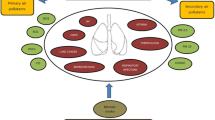Summary
A procedure for the fractionation of tobacco smoke condensate (for 100 g), well-suited for the production of aliquots for animal experiments, is described.
The separation into fractions is obtained by the phase pairs, cyclohexane-methanol-water and nitromethane-cyclohexane, as well as by column chromatography with silica gel. pH shifts and high temperature influences are avoided.
The amount of various constituents of smoke in the individual fractions is investigated. More than 85% of the phenanthrene, anthracene, pyrene, fluoranthene, benz(a)anthracene, chrysene, benz(e)pyrene, benz(a)pyrene, perylene, anthracene, benz(ghi)perylene, dibenz(a,h)-anthracene and coronene are concentrated in a fraction which accounts for only 1.1% of the total condensate. 94% of the nicotine alkaloides and 84% of the phenols are concentrated in another fraction.
By the separation procedure described it is possible to obtain a fraction from cigarette smoke condensate which accounts for only 1.1% of the whole condensate, which is free of nicotine alkaloides and phenols and which contains nearly all polycyclic hydrocarbons present in cigarette smoke.
Zusammenfassung
Es wird ein Verfahren zur Fraktionierung von Tabakrauchkondensat (für 100 g) beschrieben, das zur Herstellung von Fraktionen für Tierversuche gut geeignet ist.
Die Trennung in Fraktionen wird mit den Phasenpaaren Cyclohexan-Methanol-Wasser und Nitromethan-Cyclohexan, sowie einer Säulenchromatographie an Silikagel erreicht. Dabei werden pH-Verschiebungen und starke Temperatureinwirkungen vermieden.
Es wurde die Menge verschiedener Rauchinhaltsstoffe in den einzelmen Fraktionen untersucht. Mehr als 85% des Phenanthrens, Anthracen, Pyren, Fluoranthen, Benz(a)anthracen, Chrysen, Benz(e)pyren, Benz(a)pyren, Perylen, Anthanthren, Benz(ghi)perylen, Dibenz(a,h)anthracen und Coronen sind in einer Fraktion angereichert, die nur 1,1% des Gesamtkondensates beträgt. 94% der Nicotinalkaloide und 84% der Phenole sind in einer anderen Fraktion konzentriert.
Dieses bedeutet, daß durch das beschriebene Trennverfahren eine Fraktion aus Zigarettenrauchkondensat gewonnen werden kann, die nur 1,1% des Gesamtkondensates beträgt, frei von Nicotinalkaloiden und Phenolen ist und den größten Teil der im Zigarettenrauch vorkommenden polycyclischen Kohlenwasserstoffe enthält.
Similar content being viewed by others
Literatur
Day, T. D.: Carcinogenic action of cigarette smoke condensate an mouse skin. Brit. J. Cancer 21, 56–81 (1967).
Einheitliche Vorschriften für die Analyse von Tabak und Tabakrauch: Beitr. Tabakforsch. 3, 87 (1965).
Elmenhorst, H., u. W. Dontenwill: Nachweis cancerogener Kohlenwasserstoffe im Rauch beim Grillen über Holzkohlenfeuer. Z. Krebsforsch. 70, 157–160 (1967).
Grimmer, G.: Auftrennung eines Cigarettenrauchkondensates in Kohlenwasserstoffe, phenolische, saure, basische und neutrale Fraktionen. Beitr. Tabakforsch 1, 291–297 (1962).
—, u. A. Hildebrandt: Kohlenwasserstoffe in der Umgebung des Menschen. I. Eine Methode zur simultanen Bestimmung von dreizehn polycyclischen Kohlenwasserstoffen. J. Chromatog. 20, 89–93 (1965).
Lorentzen, G., u. G. Neurath: Quantitative Bestimmuung von Phenolen im Tabakrauch mit 4-Aminoantipyrin. Beitr. Tabakforsch. 2, 73–78 (1963).
Roe, F. J. C., M. H. Salaman, J. Cohen, and J. G. Burgan: Incomplete carcinogens in cigarette smoke condensate: Tumour promotion by a phenolic fraction. Brit. J. Cancer 13, 623–633 (1959).
Wynder, E. L., and G. Wright: A study of tobacco carcinogenesis. I. The primary fractions. Cancer (N.Y.) 10, 255–271 (1957).
Author information
Authors and Affiliations
Rights and permissions
About this article
Cite this article
Elmenhorst, H., Grimmer, G. Polycyclische Kohlenwasserstoffe aus Zigarettenrauchkondensat. Z Krebs-forsch 71, 66–73 (1968). https://doi.org/10.1007/BF00524504
Received:
Issue Date:
DOI: https://doi.org/10.1007/BF00524504




